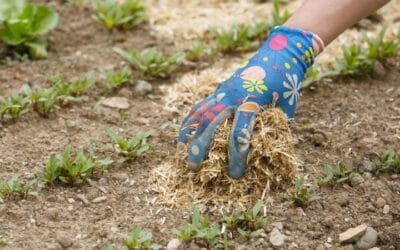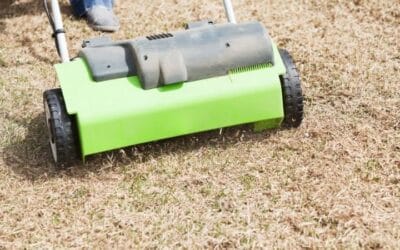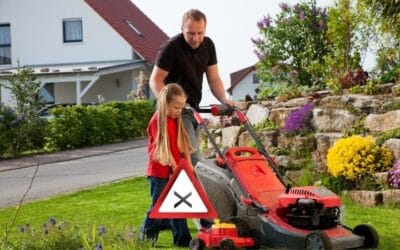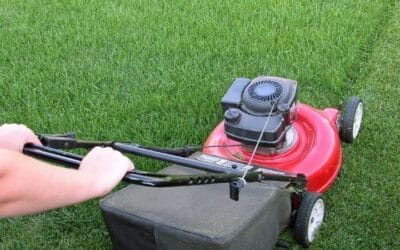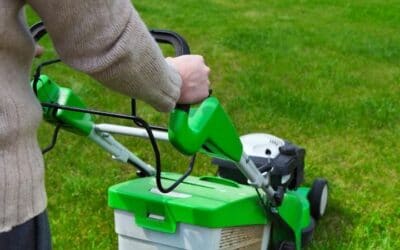Fall Lawn Care | Essential Fall Lawn Care Tips
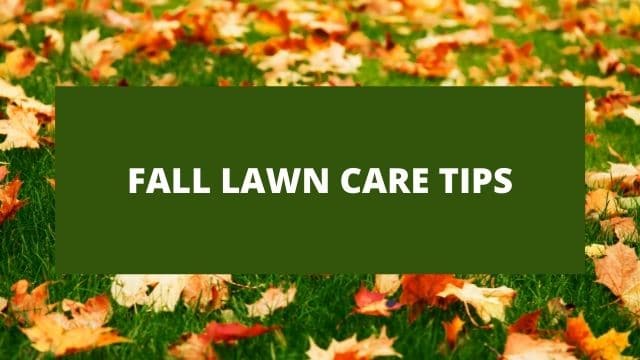
Fall has come with its cool weather, and you do not know how to maintain your lawn to be healthy and strong. You really want to improve your landscape’s appearance, and having a lush lawn all year round is your goal. If that is the case, you do not have to worry.
Fall is a special time for people who have lawns. Warm days followed by cool and wet nights are ideal turf growing conditions, so fertilization of the grass is recommended to ensure growth through winter. Fall fertilization will not only encourage new root growth (so that less grass dies back in winter), but it also helps to maintain color by promoting new growth.
In this article, I share with you great fall lawn care tips, so read on. Fall is not the time for you to cease your lawn maintenance hustle. A little work during this time will pay off when warmer temperatures come with spring. Whether it is aerating, fertilizing, weed controlling, watering, or mowing, fall is a great time to maintain your lawn.
Fall lawn care involves three major things: Fall fertilization, Fall over-seeding and Fall aeration. Fall Fertilization: Fall fertilization is the last thing that will be done for your lawn in fall as it requires a fertilizer specifically designed for this time of year. Fall is not the best time to fertilize unless you have a specific Fall fertilizer that includes Fall weed control. First of all, we will give you a clear idea, before going into detail.
Fall Fertilization:
Fall fertilization is the last thing that will be done for your lawn in fall as it requires a fertilizer specifically designed for this time of year. Fall is not the best time to fertilize unless you have a specific Fall fertilizer that includes Fall weed control.
Fall fertilizer will promote new grass growth and kill Fall weeds at the same time. Fall weed control is much more effective than Spring or Summer weed control because Fall weeds are most vulnerable to chemical treatment when just a few inches tall, whereas in other seasons they have grown out of reach of herbicides.
Fall over-Seeding:
Fall over-seeding is simply the spreading of Fall seed on top of an existing lawn. Fall aeration must be done first to loosen compacted soil and kill Fall weeds; Fall over-seeding can then follow using a mixture of Fall seeded grasses that will best suit your needs. Some examples of Fall seeded grasses are Fall rye, Fall fescue and Fall ryegrass. Fall seeded grasses germinate when Fall temperatures drop below 70 degrees F (21 C), so they will start to grow in Fall after the first frost.
Fall Aeration:
Fall aeration can be done using either a mechanical (plug-in) device or by hand with a Fall spade or Fall aerator. Fall aerators are easier to use but not as effective; Fall plugs made with a machine don’t come out of the ground, and Fall spades remove much more turf than machines do. Fall aeration is usually done once in Fall, although it may be necessary to repeat the process up to three times if heavy Fall weed infestation or Fall compaction has occurred. Fall aeration should be done in Fall so that the grass has time to recover before winter; also, Fall weeds have not yet started to germinate, so there is no risk of Fall fertilizer damaging them as it drifts onto Fall-germinating weeds.
Carry out a soil test
It is essential to test your soil’s pH and nutrition if you are to eliminate any guesswork. Fall soil testing helps you to know which improvements you ought to make to achieve healthy grass. By maintaining your lawn according to the soil test’s recommendations, your soil can be better prepared before harsh weather conditions come. Liming, for example, if done in fall, will restore the balance of the soil’s pH, and come spring; you will see a healthy lawn.
Remove leaves
Autumn leaves are the last thing you want to see in your grass. Although they may look nice on your lawn, they do more harm than good to your grass. Leaves block sunlight and trap moisture, which is detrimental to the health of your grass. It is important to rake away any leaves that fall into your lawn regularly. You can compost the raked leaves.
If the leaves are in small quantities, you can mulch them. A blower vac can make the clearance of leaves and debris less of a chore. If you dread the process of raking away leaves that fall on your lawn, you might want to consider buying a blower vac. It will make your lawn maintenance task easy and worthwhile.
Feed and water your lawn
It is important to feed and water your lawn for improved growth, drought resistance, and disease resistance to all types of lawns.
Lawn feeding
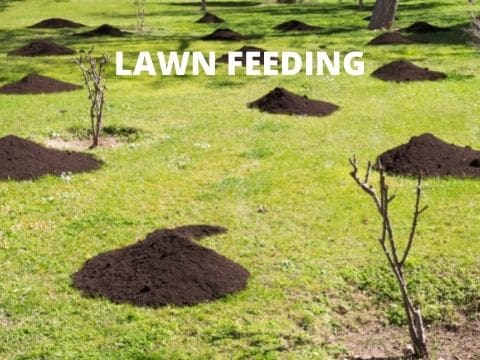
Use a high nitrogen fertilizer such as Pennington Ultragreen Lawn Fertilizer 30-0-4 to help your grass establish stronger roots and survive the coming cold winter months. If you live in the North, there is no better time to fertilize your lawn than fall.
Many cool-season grasses like bluegrass, ryegrass, and fescue perform well when fertilized in September and early fall. If you live in the South and have warm-season grasses, fall is not a great time to feed your lawn. Only when you have overseeded warm-season grasses with winter ryegrass can you apply fertilizers.
Continue watering
One of the most popular fall lawn care tips is watering, and I could not leave it out in this article. Though there will be less evaporation and more precipitation in the fall, you do not have to cease watering your grass. It is a fact that growing grass needs water, including precipitation, to be healthy and fight weeds.
There are cases when the summer drought continues through autumn. You ought to water your grass deeply several times to ensure your grass’s healthy growth in such cases. It is pivotal to water your lawn in autumn to prepare it for the coming winter months. Water your grass in the morning and also in the evening to minimize evaporation by stronger winds.
Overseed with thin lawns and repair bare spots
We already mentioned first that fall overseeding should be done in fall, As the damaged and worn out lawn needs to be repaired and overseeded. This helps the lawn to look more attractive when the entire space is covered with green.
Lawn overseeding
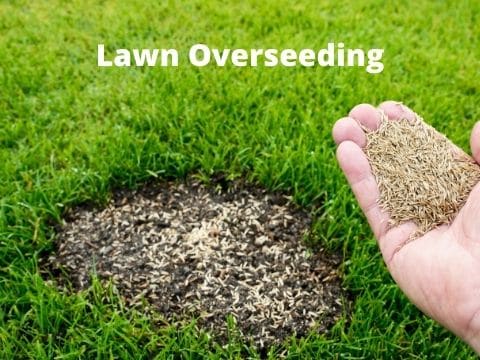
Fall is the ideal time to overseed grass because soils are warm, and precipitation is abundant. Soil warmth and plentiful precipitation mean better seed germination and establishment. The overseeding lawn will help you achieve a dense lawn that is capable of choking out weeds. Overseeding your lawn will allow you to introduce drought-resistant and resilient grasses. If you notice bare patches on your lawn, the best thing you can do is overseed it.
Repairing bare spots
Bare spots can be a pain in the neck. Fall is the best time to repair them and improve the appearance of your yard. Fall temperatures are ideal for lawn establishment, coupled with precipitation. To repair bare spots quickly, you may want to consider using a product like Pennington New and Improved One Step Complete mixture. This product is a great choice because it combines everything you need in a single product.
Control weeds and remove thatch
Weeds and thatch can be a problem, especially in early fall. They starve your grass of essential nutrients and, at the same time, make your yard unsightly.
Weeds
To combat weeds’ problem, I recommend that you work towards achieving a healthy, lush lawn rather than relying entirely on chemical weed killers. This is because a healthy, thick lawn can easily choke out weeds, which is a good thing for your lawn and the environment.
By practicing proper mowing, fertilizing, watering, etc., your grass can be in tip-top shape, enabling it to outcompete for any weeds that may infest it. For tall, stubborn weeds, grab your wedding tools, and remove these uninvited guests from your grass. Make sure you outroot weeds so that you get rid of them completely. If you must use chemical herbicides, make sure they only contact the unwanted weeds and not your grass. It is the weeds you want to get rid of, not your good grass.
Check for thatch
A thick layer of dead organic matter close to the soil’s surface can do more harm than good to your grass. Excess thatch is one of the causes of disease and pests that attack many kinds of grass, so it is important to check for it so that you can remove it asap. Thatch can develop if you overdo fertilizing and watering. To check for thatch, grab your spade and turn over a small area of grass with it. A thin layer will not harm your grass, but a thick layer definitely will.
Dethatch
Dethatching is one of the most important secrets you ought to know to achieve a healthy, lush lawn. With a tool like a power rake or vertical lawn mower, pull thatch from your grass and remove it using a hand rake. The removed thatch can be composted. When using tools like the power rake, be careful to damage some grass varieties like St. Augustine grass and centipede grass. You can opt for machines that have knives properly spaced for these grass varieties.
Keep up with lawn pest control
One big step to managing pests is following a simple routine to keep pests away from your lawn. You will need to keep mowing. Do not give in to the habit of discontinuing mowing once you not in summer, pests that love long grass are so destructive. Rake and remove leaves from your lawn; they tend to be everywhere in fall.
Pests shelter under leaves and also feed on them, regardless that they are wet or dry. Therefore declutter your yard as it gets windy in fall. The wind blows all kinds of debris, making it cluttered and inviting to pests to the harbor. In early fall, it’s that time you need to take care and manage pests on your lawn.
Pests are highly active than ever during the fall season, while a lot of pests thrive during autumn. You can either reach out to experts to help identify and control pests or use pesticides yourself. When winter ends, the lawn grows more, and insects can cause problems to the lawn. If you want to get rid of weeds from your lawn to manage pests, fall is the best timing you need.
Keep mowing
It is very essential to continue to keep mowing in fall lawn care. Continue practising good mowing, suitable for your type of grass. If you had set your mower to a high cutting setting in summer, in fall, return the mower deck to normal cutting height. If you cut your lawn slightly shorter, it won’t mate down under debris and snow that come with autumn. You do not want that.
Note: Do not cut the grass too short as it will cause your grass to have fewer roots, which leaves it susceptible to weeds. If fungal diseases are a challenge, the more you need to mow your lawn a bit shorter than normal.
Aerate the lawn
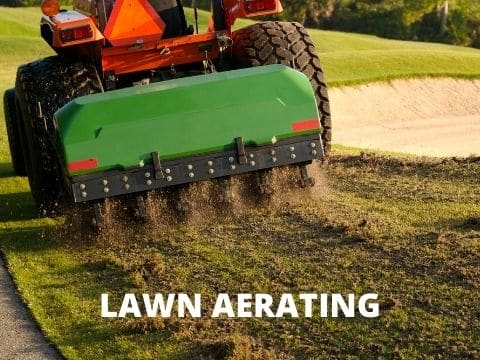
Aeration is key if you want to achieve a healthy, lush lawn. If thatch is a problem, aeration will help reduce thatch. If you want to loosen your soil, improve drainage and fertility, aeration is the way to go. Aeration is one of the fall lawn care tips that you ought to know if you want your soil to better receive oxygen, fertilizer, and water.
Core aerators are the best type of aerators. Be it plugs of soil or thatch, core aerators effectively break them up. In the process, soil structure is improved, and the grass grows thick and healthy. Cool-season grasses should be aerated in early fall, while warm-season grasses ought to be aerated in spring.
Apply a topdressing
Although it is the least mentioned fall lawn care tips, top-dressing is quite important. If you want your lawn to grow well in fall and all year round, apply a topdressing to your existing turf. The application of a thin layer of soil or compost to your grass is referred to as topdressing. Topdressing comes with several advantages that you do not want to miss.
Whether you want to do away with excess thatch, have more organic matter in the soil, and make the soil more fertile, applying a topdressing is rewarding. There will be less need for you to apply fertilizers if you do your topdressing well. Before topdressing, make sure you aerate first. To topdress, spread a quarter or half an inch of great soil over your grass, making sure to focus more on problematic areas.
Drain Irrigation Lines
Before you start draining your irrigation lines check with specifications and instructions that came along with your equipment. You can opt for either the automatic or manual draining valves depending on your installation. It is advisable to use professional help if you prefer using compressed air to blow out the sprinkler system.
If this is not done properly, serious injuries can occur. Using compressed air removes almost all the air from sprinkler heads and pipes but can also easily damage the system. The pressure has to be maintained below 40 psi. Check for leaks, replacement, and repair needs on heads and nozzles. With fall lawn care, people easily overlook their irrigation systems.
The irrigation system has to be adequately prepared for winter, considering the automated irrigation system in landscapes. Failing to prepare will lead to severe and costly system damages. If some of the water remains in the pipes, it is susceptible to freezing, leading to an outburst of pipes. Pipes above the ground are of great concern as they are highly exposed to cold and hot conditions.
Keep a Tight Schedule
To get the best out of your lawn, you must maintain a tight schedule. Observe and execute the fall lawn care stages like clockwork. This practice will help assure you have a healthy lawn for the coming seasons. If you hardly get the time for your lawn, make use of expert help. Schedule maintenance for namely early fall, mid-fall, and late fall. During the early fall, tackle the dead areas of your lawn, thin grass patches, and bare spots.
If your lawn has annual weeds, they will soon die; there is no need to treat them. During the mid-fall, aerate and overseed the lawn. This prepares grass for a healthy lifecycle, do not fertilize but focus on edging and trimming. And for late fall, clear leaves and debris from the lawn and mulch. The debris affects your lawn from getting proper water and sunlight.
To Wrap Up
Having a healthy, lush lawn all year round is achievable. All you need is a lawn care schedule. In the fall, it is pivotal to take advantage of cool temperatures to improve your lawn’s growth. Fertilize, mow and water your lawn to prepare your grass for the coming warmer months. If you want to see a healthy, greener carpet in spring, you must maintain your lawn in fall properly. With the aforementioned fall lawn care tips, the results will shock you, I assure you.

Kazi Taslim
Editor
Poweredgrip ensures that an expert team of writers provides you with excellent, unbiased informational content. We are dedicated to giving you the most up-to-date and smoothest information possible. We share incomparable tips and tricks that give you awareness and confidence when making your buying decisions. Our team is enthusiastic, dedicated, and hardworking. Kazi Taslim is the editor and head of our experienced writing team.
Related Post
Benefits of Mulching | Tips on Mulching Grass Clippings
When starting to cultivate your interest in gardening, you will constantly be looking for ways to improve your plants. You could be curious if getting dirty from handling the mulch is worth it. Well, you have searched in the right place at the right time as well. In...
Winter Lawn Care | Basic Tips of Winter Lawn Care
Winter is characterized by extreme weather conditions that can stress your lawn, making winter lawn care important. Cold and dry spells are likely to reduce the growth rate of your lawn. Most grasses enter dormancy during this cold season. Also, to make matters worse,...
Best Time to Dethatch Lawn | Lawn Dethatching Tips
We all see lawns in parks or around buildings such as a house, office, apartments, or commercial premises. Gardens provide an enticing look, and people keep and maintain lawns for the scenic or recreational feel. However, this beautiful green requires a lot of work...
Lawn Mowing Safety Tips | To Know Before You Mow
Mowing your lawn is one of those "macho" chores that are generally regarded as masculine. The whole idea of crank starting the mower's petrol engine and getting all sweaty pulling and pushing it forth makes one feel invincible. "What could really go wrong?" you might...
When to Start Mowing Lawn | The First Cut of The Year
Lawn mowing is not an event confined to a specific calendar date. Instead, you should monitor your grass length and mow only when necessary. Every homeowner or gardener needs to know when to start mowing lawn to maintain a clean and neat grass cut. This article will...
How Often to Mow Lawn: Guide to Avoid Mowing Mistakes
It is said sweet comes from sweat. The same goes for achieving a good lawn. You do not just wake up one day and see a beautiful lawn in your yard. You need to maintain your lawn if you want it to be healthy and beautiful. Mowing grass is a must-do if you're going to...

